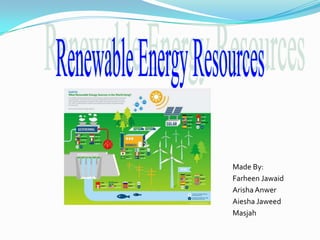
Hydro power ppt
- 1. Made By: Farheen Jawaid Arisha Anwer Aiesha Jaweed Masjah
- 2. WHAT IS RENEWABLE ENERGY? Renewable energy is energy generated from natural resources—such as sunlight, wind, rain, tides and geothermal heat—which are renewable (naturally replenished). Renewable energy technologies range from solar power, wind power, hydroelectricity/micro hydro, biomass and biofuels for transportation.
- 3. What is Hydropower Hydropower refers to energy, mostly electric, which is derived from water in motion. This power is harnessed and used to drive mechanical devices. The main advantage of this form of energy is that it is clean and renewable. Hydropower plants are actually based on a rather simple concept -- water flowing through a dam turns a turbine, which turns a generator.
- 5. Flow Chart Potential impact Economic impats Social issues Hydropower Enviromental impacts benefits Draw backs
- 6. SOCIAL ISSUES Relocating people from the reservoir area is the most challenging social aspect of hydropower, leading to significant concerns regarding local culture, religious beliefs, and effects associated with inundating burial sites. While there can never be a 100 percent satisfactory solution to involuntary resettlement, enormous progress has been made in the way the problem is handled.
- 8. Environmental Impacts Hydroelectric power includes both massive hydroelectric dams and small run-of-the-river plants. Large-scale hydroelectric dams continue to be built in many parts of the world (including China and Brazil), but it is unlikely that new facilities will be added to the existing U.S. fleet in the future. Instead, the future of hydroelectric power in the United States will likely involve increased capacity at current dams and new run-of-the-river projects. There are environmental impacts at both types of plants.
- 10. Advantages 1. Once a dam is constructed, electricity can be produced at a constant rate. 2. If electricity is not needed, the sluice gates can be shut, stopping electricity generation. The water can be saved for use another time when electricity demand is high. 3. Dams are designed to last many decades and so can contribute to the generation of electricity for many years / decades. 4. The lake that forms behind the dam can be used for water sports and leisure / pleasure activities. Often large dams become tourist attractions in their own right. 5. The lake's water can be used for irrigation purposes.
- 11. Disadvantages 1. Dams are extremely expensive to build and must be built to a very high standard. 2. The high cost of dam construction means that they must operate for many decades to become profitable. 3. The flooding of large areas of land means that the natural environment is destroyed. 4. People living in villages and towns that are in the valley to be flooded, must move out. This means that they lose their farms and businesses. In some countries, people are forcibly removed so that hydro-power schemes can go ahead. 5. The building of large dams can cause serious geological damage. For example, the building of the Hoover Dam in the USA triggered a number of earth quakes and has depressed the earth’s surface at its location.
- 12. SIGNIFICANCE Hydropower stands as the most significant renewable energy source. It uses the single but very powerful energy force of moving water. By some comparison, it competes with the energy produced by fossil fuels and nuclear power, but is considered much cleaner and more simplistic. Hydropower remains popular even in third-world countries, which do not have the resources to build expensive nuclear generating stations. Hydropower does not pollute the atmosphere or environment.
- 13. Facts Hydropower uses the energy of moving water for a variety of useful applications. Hydroelectricity generates electricity by harnessing the gravitational force of falling water. In 2006, hydroelectricity supplied around 20% of the world’s electricity. Most hydroelectric power stations use water held in dams to drive turbines and generators which turn mechanical energy into electrical energy. The largest hydroelectric power station in the world is the Three Gorges Dam in China.
- 15. Types of Hydropower Impoundment An impoundment facility, typically a large hydropower system, uses a dam to store river water in a reservoir. The water may be released either to meet changing electricity needs or to maintain a constant reservoir level. Diversion A diversion, sometimes called run-of-river, facility channels a portion of a river through a canal or penstock. It may not require the use of a dam. Pumped Storage When the demand for electricity is low, a pumped storage facility stores energy by pumping water from a lower reservoir to an upper reservoir. During periods of high electrical demand, the water is released back to the lower reservoir to generate electricity.
- 16. Economic Impacts Large dams have long been promoted as providing "cheap" hydropower and water supply. Today, we know better. The costs and poor performance of large dams were in the past largely concealed by the public agencies that built and operated the projects. Dams consistently cost more and take longer to build than projected. In general, the larger a hydro project is, the larger its construction cost overrun in percentage terms.
- 17. Environmental Impacts The IHA (International Hydropower Association) Working Group on Environmental Impact Assessment (EIA) calls for impact assessment to be an integral part of the multidisciplinary planning approach, and to include a strong element of public consultation. EIAs should cover both positive and negative impacts both upstream and downstream of a proposed project.
- 18. Bibliography Weblinks: Google.com http://pbs.gov.pk/content/what-are-major-sectoreconomy-pakistan http://environment.nationalgeographic.com/environ ment/energy/great-energy-challenge/worldelectricity-mix/